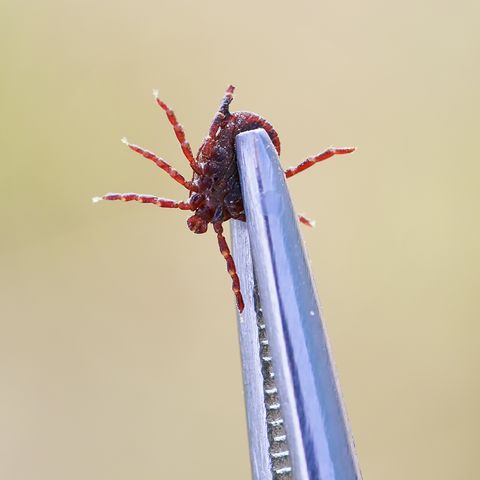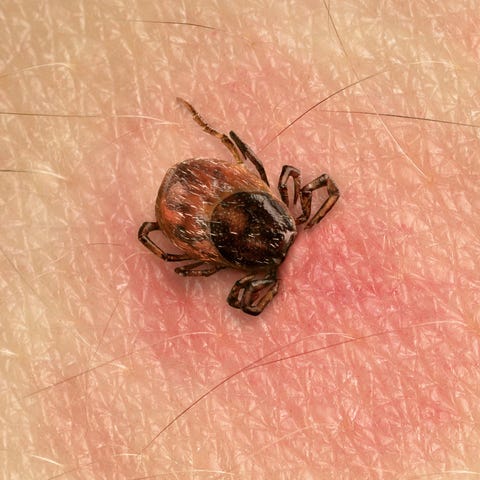Tick-born illnesses continue to be on the rise in the United States: The Centers for Disease Control and Prevention (CDC) reports that, since 2004, nine new germs spread by bites from infected mosquitoes and ticks were discovered or introduced in the United States.
The good news is, a tick has to be attached to you for 36 to 48 hours in order for you to catch a disease from it, says Gaspere Geraci, M.D. Market Chief Medical Officer for AmeriHealth Caritas, a Medicaid managed care organization. “If you find it within a day or so, you will likely be fine,” he says. If you check yourself, your family, and your pets regularly, you’ll reduce the risk of getting tickborne illnesses — provided you do it the right way.
Take it out with tweezers.
It may be gross, but you just have to get in there and pull it out.
“Take a deep breath and pretend that it’s just a speck of lint — not an ugly critter with a bloated stomach and writhing legs,” says Naline Lai, M.D., who co-runs who co-runs the Two Peds in a Pod blog with Julie Kardos, M.D.
Here are the proper steps for removing a tick, according to the CDC:
- Using a pair of fine-tipped tweezers, grasp the tick as close to the skin as possible.
- Pull straight up with steady, even pressure. “Press down on the skin on either side of the tick so that the skin doesn’t pull up when you pull the tick off,” Dr. Lai says. “This lessens any pinching sensation your child may feel.”
- Thoroughly clean the bite (and your hands) with rubbing alcohol or soap and water.
The CDC discourages “folklore remedies” like nail polish, petroleum jelly (Vaseline), and heat that lift the tick away from the skin, since they rely on waiting for a tick to detach, which takes longer. “Anything that delays removing a tick is a bad idea,” says Robert B. Kimsey, Ph.D, an entomologist with the University of California, Davis specializing in ticks.
“Suffocating a tick is not very effective,” Dr. Kardos says. “Covering a tick with petroleum jelly or nail polish may even cause the tick to become slippery and more difficult to grasp. And don’t try to burn a tick off — you’ll just burn your child’s skin.”
What happens if you don’t remove a tick?
Some species of ticks in certain parts of the country can transmit illnesses like Lyme disease, Rocky Mountain spotted fever (RMSF), and southern-tick associated rash illness (STARI), the CDC states. While not every tick carries pathogens, waiting too long to remove a tick can increase the likelihood of transmission.
“In general, it takes anywhere from a day and half to two days or so for a tick that’s attached to you to transmit any pathogens it may have,” Dr. Kimsey says. “Once that tick attaches to you, that sets a timer and you’re best off getting it off just as quickly as you can.”
How do you get a tick to let go?
The short answer: You can’t. “Ticks, as an initial process of feeding on you, actually glue themselves in place,” Dr. Kimsey explains. “The hard ticks that people are most concerned about can’t back out of their own volition.”
So not only is it a bad idea to wait to grab peppermint oil, dish soap, Vaseline, or whatever fix the internet is currently prescribing for tick bites, but these home “remedies” may also not work the way you believe they do.
What happens if you squeeze a tick?
Those worries about whether squeezing a tick may cause it to regurgitate more pathogens into the bite may be misguided.
A while ago, Dr. Kimsey attempted a series of informal experiments to test whether this would be the case. He and research fellow at the Harvard School of Public Health removed engorged ticks from their hosts and prodded them with pencil erasers under a microscope.
“They didn’t regurgitate, they didn’t explode, and they didn’t salivate any more then they were going to anyway,” he said.
What do you do if you pull out a tick and the head breaks off from the body?
What you may think of the tick “head” is actually not the head at all. “If anything gets left behind in the skin, it’s the mouthparts, essentially tick jaws,” Dr. Kimsey says.
The CDC recommends attempting to remove any mouthparts left behind with clean tweezers, but if they don’t come out easily, just leave it alone and let the skin heal. That’s because they’re not infectious in the same way as an actual tick.
“There are no pathogens associated with tick jaws,” Dr. Kimsey says. “Your skin will reject the mouthparts in the same way they will reject a splinter.”
What should you do after getting rid of a tick?
“Once the tick is removed, dispose of it properly: Flush it down the toilet or put it in a plastic bag where it won’t escape,” Dr. Geraci says.
Whether you decided to save a tick and get it identified or tested should depend on where you live. “There’s a lot of data out there now about where the prevalence of infected ticks is relatively high and where it’s relatively low and what kinds of ticks actually carry pathogens and which ones don’t seem to,” Dr. Kimsey says. “Make that kind of decision based on knowledge, not panic.”
Talk to your healthcare provider if you have any questions about tickborne illness in your area, and of course see your doctor right away if you develop a rash or fever within several weeks of removing a tick, the CDC advises.
The redness and swelling you may see a few hours after a tick bite isn’t necessarily a cause for concern, though. It shows that your body is recognizing the foreign proteins in the tick saliva and using an immune response to flush them out, just like with a mosquito bite. “In the reality, that initial reaction to the tick saliva occurs long before any pathogens get transmitted,” Dr. Kimsey says. “It’s just your immune system doing its job.”
This content is created and maintained by a third party, and imported onto this page to help users provide their email addresses. You may be able to find more information about this and similar content at piano.io


